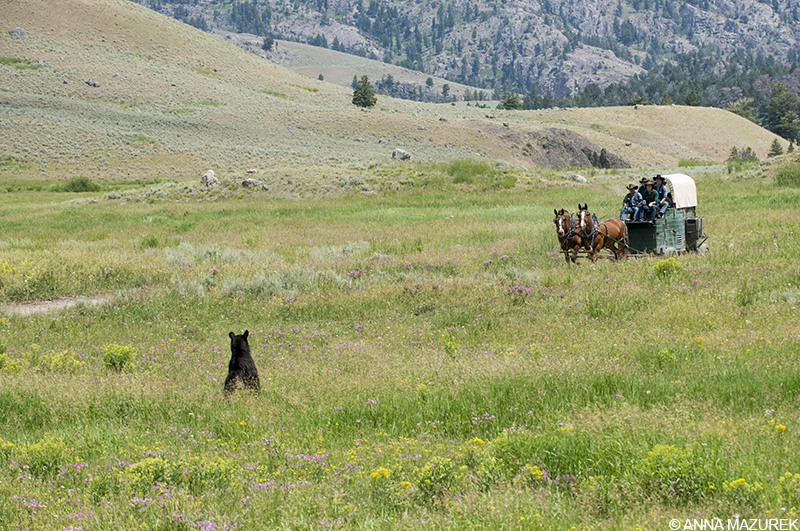
A black bear stands up to greet a wagon near the Roosevelt Lodge in Yellowstone National Park. There were black bear sightings two days in a row near the lodge during our trip.
Despite being on my bucket list, I kept pushing back my plans to go to Yellowstone National Park. My goal was always to take two months and do an epic road trip through the major national parks in the Western U.S. The summer of 2019 was the plan. Then, National Geographic Student Expeditions offered me a position to run a Yellowstone Photo trip. Clearly, I said yes instantly. Here’s the best things to do in Yellowstone National Park and how to avoid the crowds in Yellowstone.
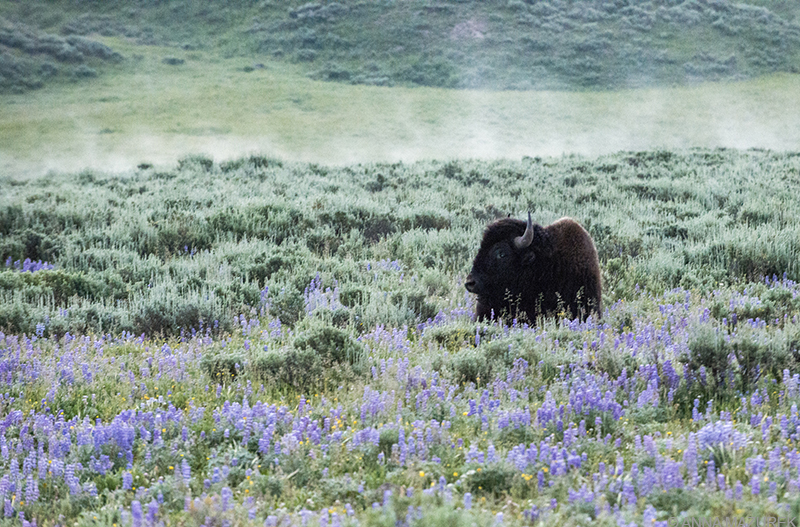
My favorite thing about Yellowstone were the bison. I miss people randomly yelling, “Bison, on the right!”
Overall, Yellowstone was stunning. I’ve never seen so much wildlife anywhere in the world. (Well, except for that time that herd of camels ran out in front of our van in India on the way to the Taj Mahal.) Despite being peak season, it was much easier to escape the crowds than I expected. I’ve put together a photo guide to Yellowstone that includes top sights ad when to go along with budget and photo tips. Enjoy! (For detailed maps of the park, stop by the visitors center to pick up free brochures or visit their Yellowstone National Park website or download the free app.)
Yellowstone’s Top Sites
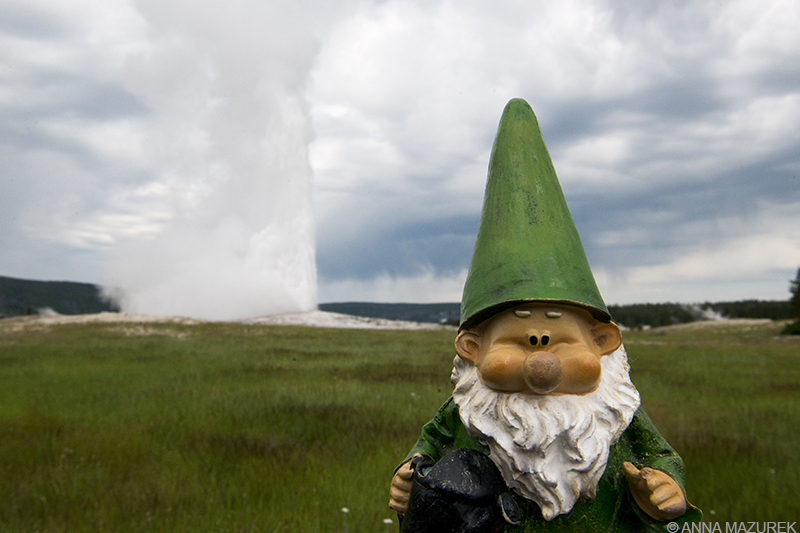
How do you take the perfect gnome photo? Find an iconic spot like Old Faithful here and position Aflred in the foreground. Shoot at a small aperture so both the foreground and background are mostly in focus. I prefer overcast days so his cheeks aren’t too shiny.
Old Faithful
The most well-known site in the park is this cone shaped geyser that ranges from 90 to 184 feet high. It’s the most predictable one in the park. Follow @GeyserNPS on Twitter for latest prediction times. Predicted times will be posted all over the visitor’s center and hotels in the area. Spend an hour or two walking through the maze boardwalks that wind between various geysers and thermal pools in the area including Morning Glory Pool.
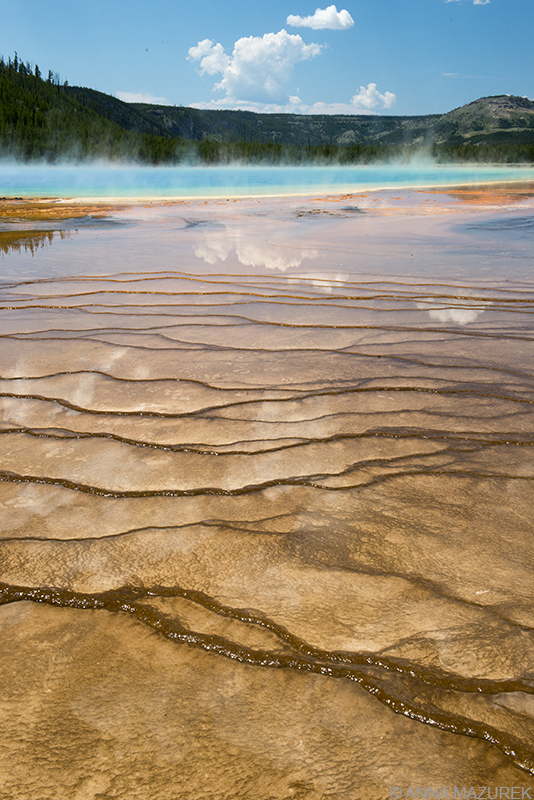
In the early afternoon, Grand Prismatic still had a bit of fog over the pool but great reflections of the clouds.
Grand Prismatic
This colorful hot spring is the largest in the U.S. and third largest in the world. It’s one of the most iconic sites in the park and located in the Midway Geyser Basin a few miles north of Old Faithful. FYI: The Fairy Falls hike that gives you a view above Grand Prismatic is closed for construction as of July.
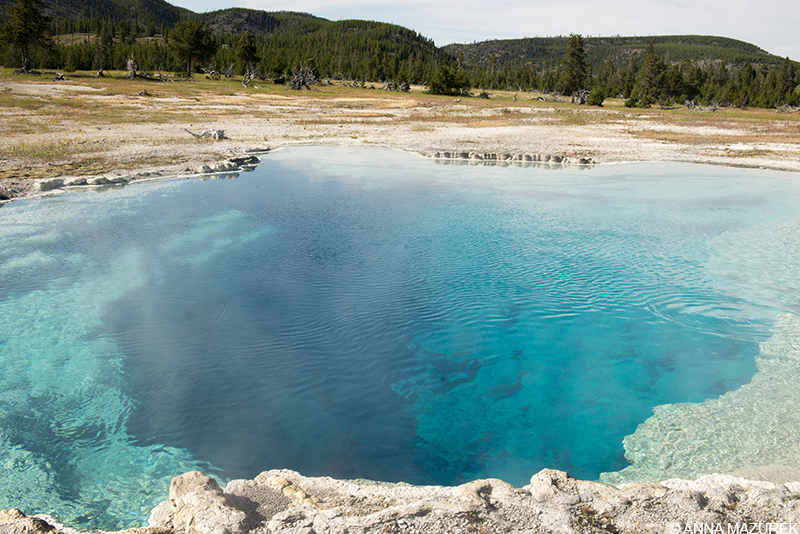
Sapphire Pool at Biscuit Basin
Biscuit Basin
This collection of thermal features including geysers and thermal pools is part of the Upper Geyser Basin. Sapphire Pool, above, is the most photogenic and named for it’s clear blue water. The boardwalk loop is 2/3 of a mile.
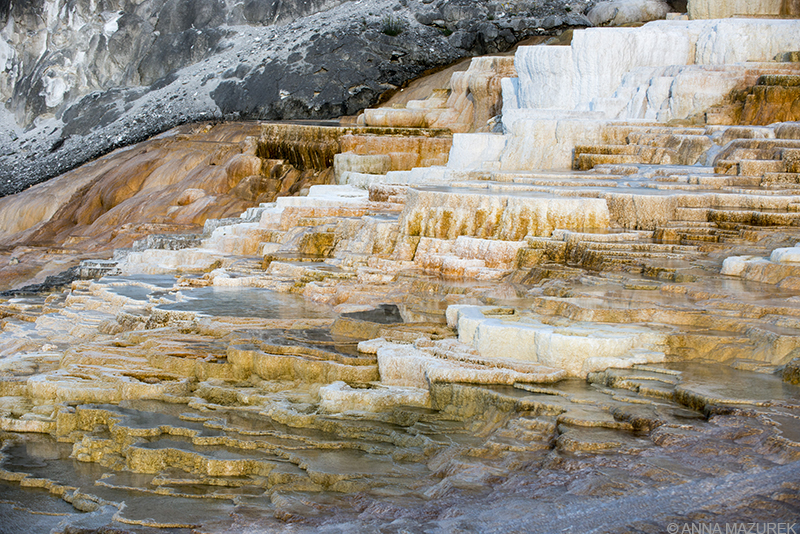
Mammoth Hot Spring is near the northern entrance to the park near Gardiner, Montana.
Mammoth Hot Spring
Located right at the northern entrance to Yellowstone, the stair-step shape of this large hotspring is impressive. The boardwalks are extensive allowing you to view it from all sides, which is good for photography. If the light is bad in one direction, you can always walk to the other side to get a better angle.
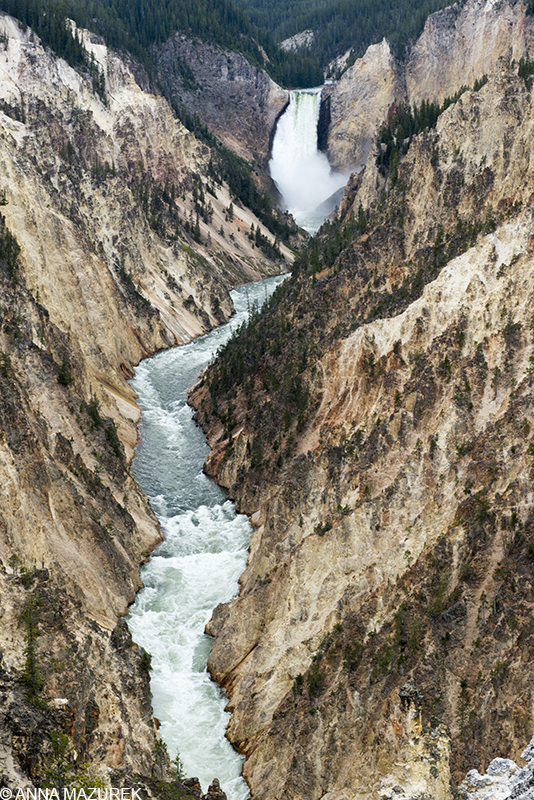
The view of lower Yellowstone Falls from Artist Point
Yellowstone Falls
The lower falls is the largest waterfall in the park at 308-feet tall. It’s the probably the second most photographed site in the park after Old Faithful. The most iconic shot is from Artist Point that gives a great view of the canyon with the waterfall in the distance. (This spot will be PACKED with tourists.) Hike the steep Uncle Tom’s Trail to get a view from the base of the falls, which is significantly less crowded.
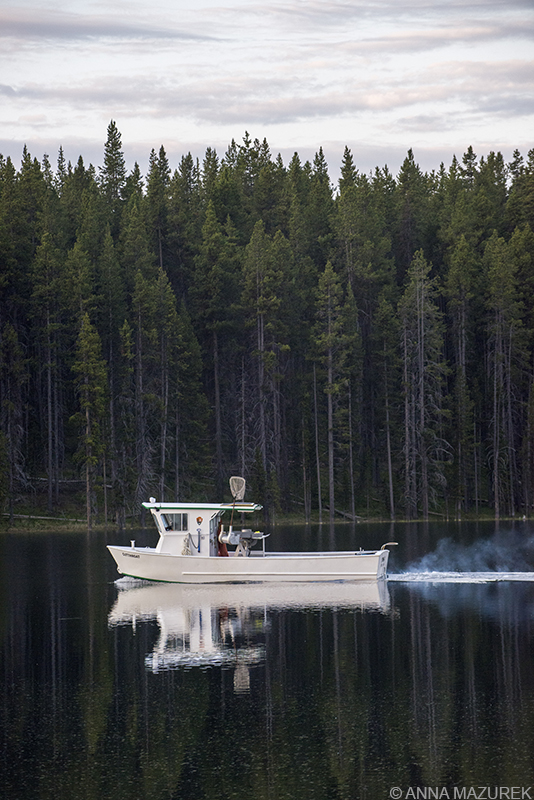 Sunrise at the marina at Yellowstone Lake
Sunrise at the marina at Yellowstone Lake
Yellowstone Lake
At 7,732 feet, the lake is the highest elevation lake in North America. It’s stunning so be sure to take advantage of the many viewpoints to stop for photos. The marina is also great for photos.
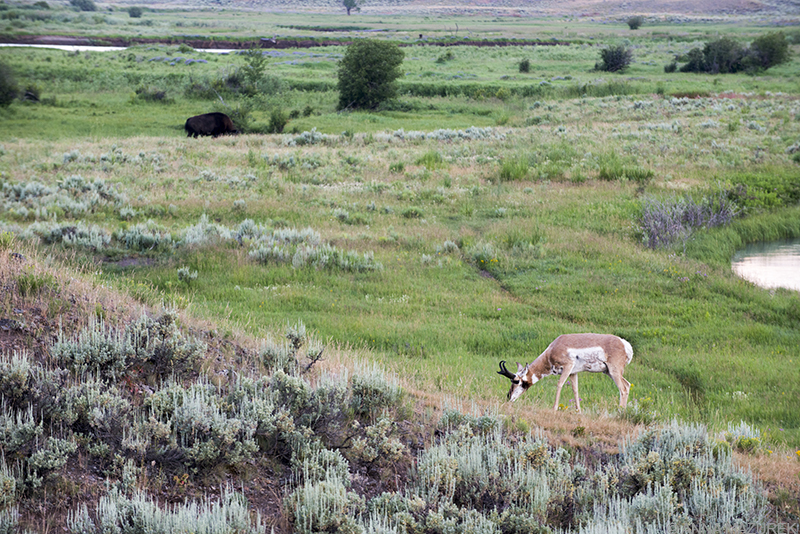
The Lamar Valley was a highlight of my trip. We saw the most animals in this section of the park including pronghorns, bison and baby coyotes.
Lamar Valley
This area is known as the Serengeti of the North America due to the high concentration of animals. The Northern bison herd hangs out in this valley and stretches north to the city of Gardiner. A sunrise drive through this area is a must for any trip. I also recommend taking a Yellowstone Forever guided tour. Our guide, Josh, was a pro at spotting wildlife that no one else noticed and could answer almost any question about the park.
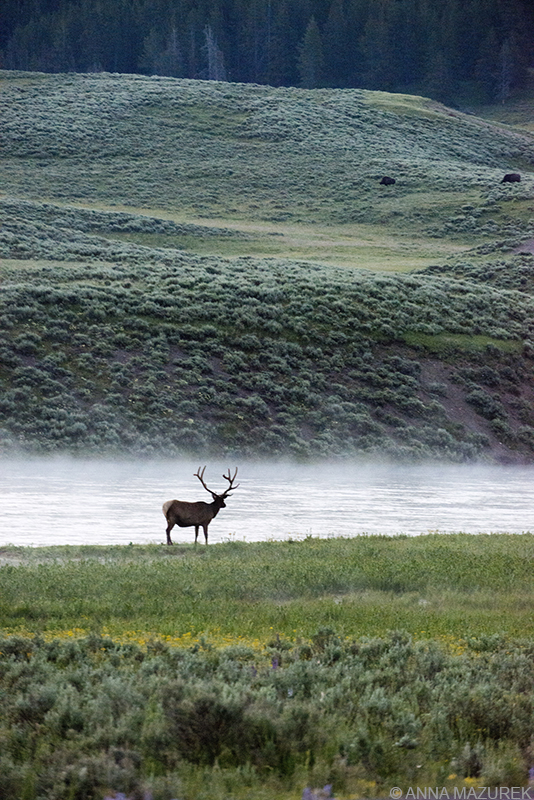
The largest concentration of elk we saw was in the Hayden Valley and along Yellowstone Lake.
Hayden Valley
This is another excellent spot for animal spotting. This area lies between the Yellowstone River and Yellowstone Lake. There’s also a high chance of spotting waterfowl as well. Again, sunrise is a great time for drive through the valley toward the lake. Since there’s plenty of pullouts, it’s easy to even take photos from the car and keep a safe distance from the animals.
How to beat the crowds at Yellowstone
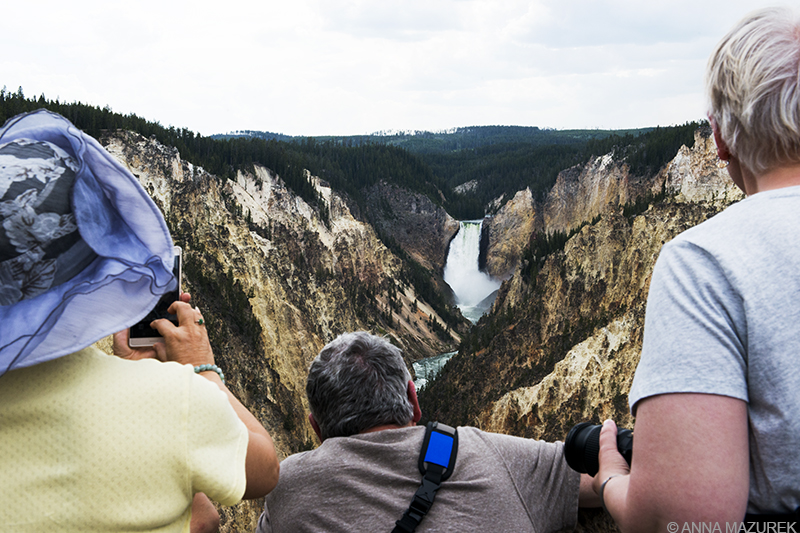
Artist Point and other easy to access locations like Old Faithful will be packed with people. Luckily, it’s easy to exclude them from images but also sometimes interesting to include for context.
Summer is peak season so I was dreading the crowds. I imagined hoards of tour buses and traffic that made rush hour on the 405 in L.A look like an F1 race. I was pleasantly surprised. Yes, there were lines of cars getting into parking lots. The majority of people get fed up and parked all along the roads, which meant that I ALWAYS found rockstar parking in the lots even though I was driving a 15-passenger van! Patience pays off when parking at Yellowstone.
Almost all the major sites in the park were empty before 10 a.m. and after 6 p.m. Sunset was around 9:15 p.m. in July when I was visiting. (The average vacationer isn’t up early and eats dinner around 6 p.m.) I was up at 4:30 a.m. most mornings and shooting until sunset. Honestly, I was seriously shocked how empty the sites were at sunset especially!
Yellowstone Budget Tips
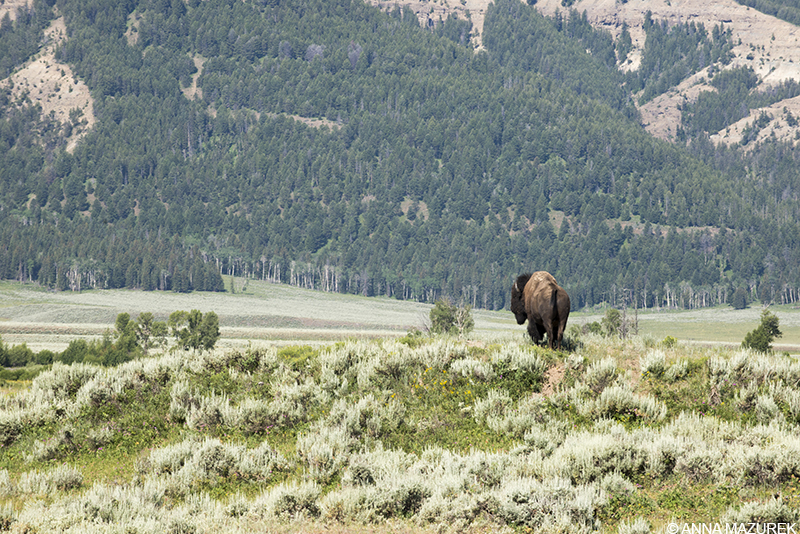
The bison herds in Yellowstone are the only contiguously present geneticly pure herd in the lower 48 states. (Fred, the bison above, lives in the Lamar Valley.)
- Take your own food. There is a lack of variety in food options in the park. The cafeteria restaurants have the exact same menu every day for both lunch and dinner. (The average meal cost without a drink was roughly $10 USD at the cafeterias.) The best restaurant was at the Obsidian Dining Room at the Old Faithful Snow Lodge. I recommend driving to the town of Gardiner at the northern entrance for meals if you run out of food or need some variety.
- Camp: The lodges are nice but expensive. There are 12 regular campgrounds with over 2,000 sites. Five campgrounds can be reserved in advance and the rest and first-come first-serve basis. There are also backcountry camping options. For more info on camping, visit https://www.nps.gov/yell/planyourvisit/campgrounds.htm
- Fee Free Dates: Take advantage of these fee free dates for national parks every year. Normally, the park entrance fee is $30 per car or $50 combo pass for Yellowstone and Grand Teton.
- Buy Gas Outside the Park: As expected, gas is more expensive and harder to find in the park. Fill up in Gardiner or any of the towns outside the park.
Yellowstone Wildlife Photo Tips
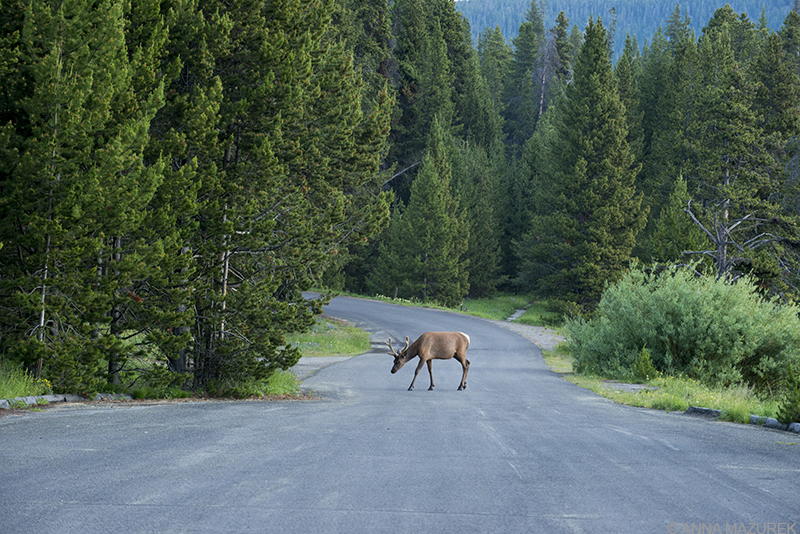
An elk wanders across a small side road by Yellowstone Lake at sunrise.
- The early bird gets the photo. We were in the car and on the road 30 minutes before sunrise almost every day. This is also great for scenic landscape shots as well as animals. The best spots for wildlife are the Lamar Valley and Hayden Valley as mentioned above.
- Be realistic with expectations. The odds of seeing a lynx are less than your odds of winning a toy from one of the arcade machines with the metal arm. You will see a ton of wildlife but aside from bison and elk, most will likely be too far away for your phone photos. We met people who waited seven hours to photograph bears.
- Take a 400mm lens. My 70-200mm lens wasn’t enough for tight animal shots or even including animals in landscapes. Thankfully, I was able to borrow a friend’s 400mm lens but even then, some animals like the baby coyotes we saw were too far away.
- Keep a safe distance. Don’t be a statistic. People get seriously injured every year getting too close to animals. We saw a guy trying to take cell phone photos of an elk and get within three feet of it! Stay at least 100 yards from bears and wolves, and 25 yards from other animals including bison and elk.
- Shoot from your car. I would pull my car over and shoot from the windows to keep a safe distance from the animals.
- Watch your composition. Be aware of your foreground and background with animals shots. Avoid distracting elements like people or cars.
- Get low. To help animals stand out from the background, get low.
- DO NOT BLOCK THE ROADS. If you see a bear and want to take photos, do not be rude and stop/park in the road. It’s not safe and causes horrible traffic problems. Pull over at the next turn off instead.
Best times for Photographing Yellowstone’s Top Sites
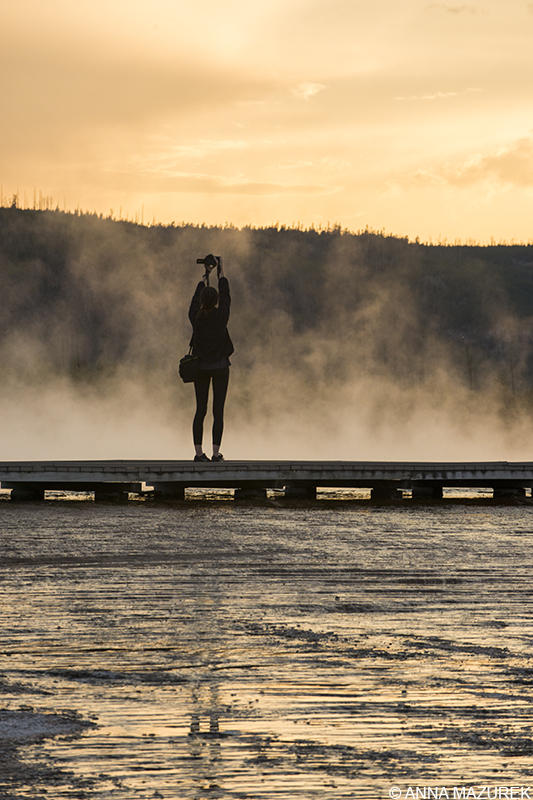
Our goal was to go back to Grand Prismatic at sunset to avoid the fog but a storm rolled. After it cleared, the fog was more intense, which still meant we got amazing photos.
Yellowstone Falls: Mid-morning (9- 10 a.m.) along the south rim of the grand canyon is best to catch light on the falls and possibly get a rainbow.
Obsidian Cliffs: Aim for mid to late afternoon to get the light glinting off the volcanic glass
Grand Prismatic & Thermal Features: For the most dramatic steam on any of our thermal features aim for a cool early morning light. For the best colors aim for a slightly breezy hot late afternoon, especially if you really want to catch the grandeur of the Grand Prismatic. (We went to Grand Prismatic in the early afternoon and the sun was harsh with a bit of fog lingering. We went back at sunset one night after a small storm. The fog was more intense like a horror movie scene but still provided excellent photos like the image above.)
To avoid people: Go before 10 a.m. and after 6 p.m. in the summer. Most tourists sleep in and have dinner around 6 p.m.
Best time to visit Yellowstone
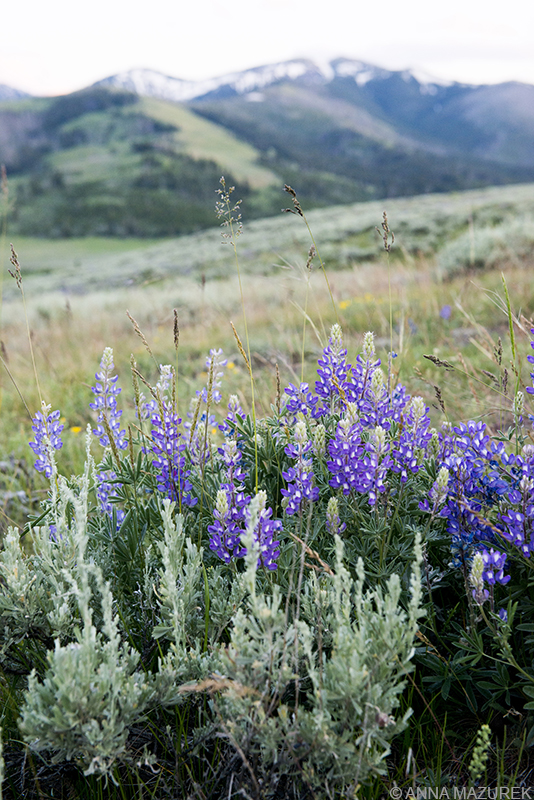
Wildflowers in the Lamar Valley in Yellowstone
For wildlife: Late May to early June before the crowds get here. The bears and babies are everywhere and closer to roads that follow the lower routes through the park meaning less snow and more greens to eat.
For the best snow and high potential for wolves, late January to early February is best.
For flowers or fall colors, mid-June at low elevation and late July at the higher elevations for flowers. Late August for the best fall colors.
__________________________________________
COMING UP:
Interview with the New York Times’ Frugal Traveler
In my next post, I chat with Lucas Peterson, the New York Times’ Frugal Traveler writer. He discusses how he cuts travel costs, his favorite food cities and the biggest myth about budget travel.


